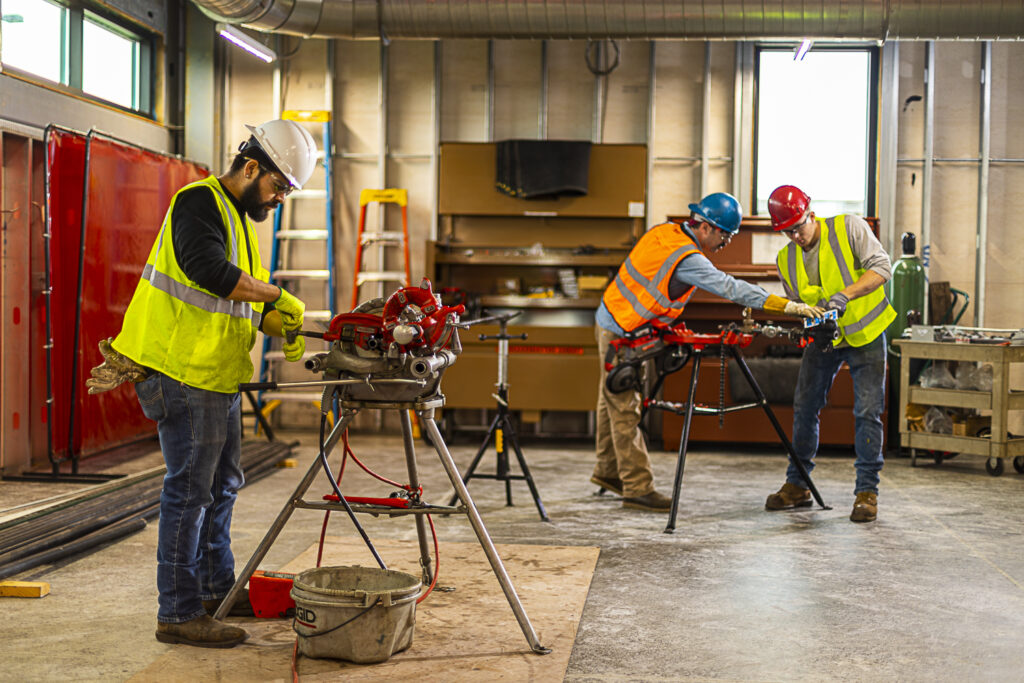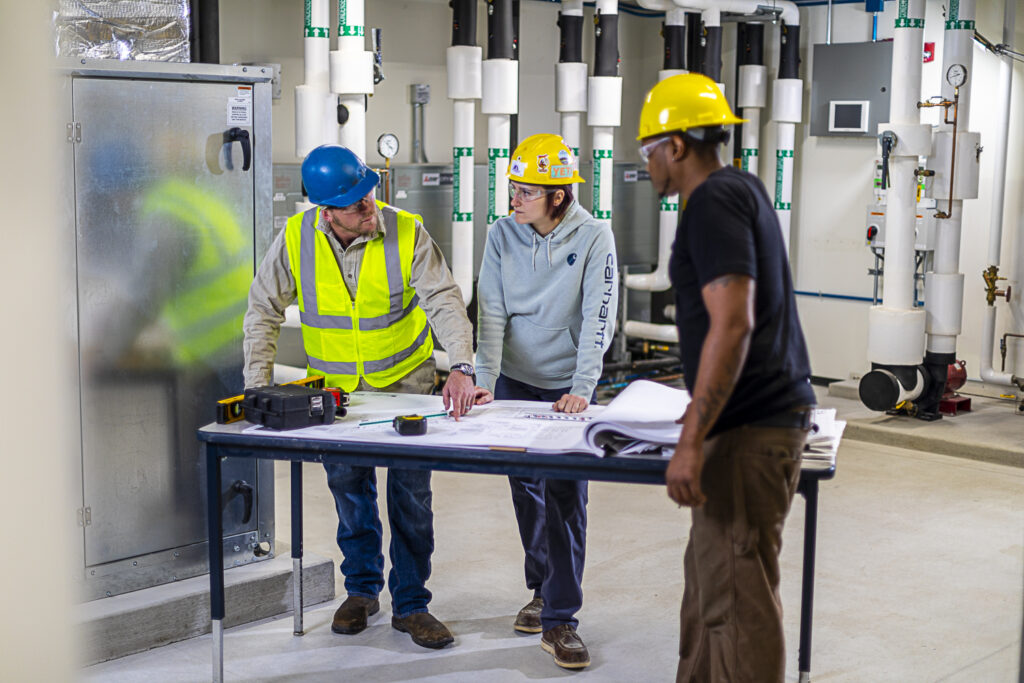HISTORY
LOCAL 601 HISTORY
Professional steamfitters in Milwaukee have been organizing to collectively work for better conditions at least as far back as 1883, when National Association of Steam and Hot Water Fitters and Helpers of America Local No. 18 was formed in the city. The United Association also established a steamfitter’s local – No. 24 – in Milwaukee just a decade later on October 6, 1893. By year’s end, the local boasted 24 members in good standing, according to UA records.
On a larger, national stage, the United Association had been created in 1889 and rivaled the National Association – which changed its name to the International Association in 1905 – within the unionized pipe-trades industry. While the International Association was comprised primarily of pipe fitters, the UA was dominated by plumbers, gas fitters and sprinkler fitters. However, in 1912, the International Association agreed to merge into the UA after the American Federation of Labor ruled that a single union, the UA, would represent all of the pipe trades.

With Local 24 lost to history sometime around the turn of the century with no recorded explanation or account of its demise, the UA soon after chartered Local No. 582 on August 27, 1912, as the steamfitters and helpers local in Milwaukee.
United Association Local No. 582, steamfitters and steamfitters’ helpers of Milwaukee, was then instituted with 43 members.
The International Association Local 18 and Local 582 reached an amalgamation agreement on February 22, 1913, to form UA Local 601, effective March 1. During a special meeting on February 25, Local 18’s membership voted to accept the amalgamation proposition from the United Association and gave its executive board “full power to act with U.A. committee,” meeting minutes recorded. With that, 197 steamfitters and helpers of Local 18 paid their $1 initiation fees and were duly initiated into Local 601 three days later during US Steamfitters Local 601’s first meeting on March 4, 1913, joining about 26 members of the UA.
Through wars and economic depression the local continued to grow and by 1935 membership was at 243 members. That same year saw the formation of a committee to build a training facility and draft a plan of apprenticeship for training Local 601’s aspiring journeyman. A new building was erected on Teutonia Avenue in Milwaukee at a cost of $22,000 and the first classes were held in December of 1942.

By the 1960’s membership was at 1300 and the local had moved to a larger facility on Burleigh Street in Milwaukee, which was further expanded in 1967. The 70’s and 80’s saw work fluctuate between bad times and good, still the membership grew to 1500 by the 1990’s. Once again the local saw the need for a larger training facility and relocated to 103rd Street in Milwaukee in 1995.
In 1997 Janesville Local 214 merged into Local 601, followed in 1999 by Madison Local 394.
Today, at over 100 years old, Steamfitters Local 601 represents approximately 2800 members in a 14 county area in Southeastern Wisconsin. While the majority of the local’s membership is comprised of steamfitters and refrigeration/service fitters, it also represents various other classifications including petroleum, warehouse, gas distribution, mainline and station pipeline work throughout the State of Wisconsin.
UNITED ASSOCIATION HISTORY
The United Association of Journeymen and Apprentices of the Plumbing and Pipe Fitting Industry of the United States and Canada, the parent Union of Local #1 in New York, has a long and proud history that goes back more than 100 years.
Before and during the Civil War, plumbers and pipefitters were organized in many major cities of the United States. The first strong, long-lasting local Unions were established in the boom construction decade, 1879-1889, when United States population growth accelerated.
Journeymen in the pipe trades in the 1880s worked in three basic crafts: plumbers, steamfitters and gasfitters.
The first truly successful national body, the United Association of Journeymen Plumbers, Gas Fitters, Steam Fitters, and Steam Fitters’ Helpers of the United States and Canada, was officially founded on October 11, 1889.
Gradually, former members of rival Unions joined the United Association. The depression of 1893-1897 slowed the development of a stronger organization. Membership in the United Association grew to 6,700 in 1893, but fell to 4,400 by 1897. Yet, by that year 151 local Unions were listed on its rolls.
Starting in 1898, the construction industry entered a period of expansion and prosperity that lasted until 1914. From 1898 to 1906 the United Association quadrupled its membership.

During its first years, the United Association was essentially a federation of local Unions, rather than a truly national Union of the pipe trades. The major breakthrough toward a unified national organization came at the 1902 national convention in Omaha, when delegates approved a Nationalization Committee proposal establishing a comprehensive system of sick, death and strike benefits.
As such reforms to strengthen the national organization were being made in the early part of the century, however, some locals broke ranks to form a rival Union. In August 1906, members of the secessionist Union realized the futility of further rivalry and agreed to affiliate with the United Association.
From 1898 to 1914, the United Association went through several phases of a struggle with the International Association of Steam and Hot Water Fitters and Helpers, a prolonged and sometimes bitter dispute both over jurisdiction over a craft (steamfitting) and work assignments (plumbers vs. steamfitters). The conflict affected other building trades when walkouts by the rival steamfitting organizations, as a result of their jurisdictional dispute, led to work stoppages by other crafts.
The strength of the United Association, and favorable rulings by the American Federation of Labor, including the revocation of the International Association’s charter in 1912, ended this jurisdictional battle, but other jurisdictional issues would continue to challenge the Union.
New disputes arose over the construction of chemical plants and other manufacturing and service establishments that required extensive piping systems. Large volumes of newer types of pipefitting installation in the shift from World War I wartime industries to peacetime construction caused considerable difficulties. Jurisdictional problems also developed with other national Unions, but the United Association retained jurisdiction over important, growing areas of work like construction of industrial plants, public utilities, petroleum facilities and residential buildings.
In the first half of the century, the United Association moved to formalize apprenticeship training programs, including making a five-year apprenticeship mandatory in 1921, and in 1938 holding that all apprentices be members of the United Association and attend related training classes. Its National Plumbing Apprenticeship Plan of 1936 was the first set of standards governing apprenticeship to win approval of the federal government.
In the Depression, United Association membership fell from its 1929 peak of 60,000 to 26,000 by 1933.
After several constitutional changes through the years, the 1946 convention changed the name of the organization to its present name: The United Association of Journeymen and Apprentices of the Plumbing and Pipe Fitting Industry of the United States and Canada.
Throughout World War II and after, the United Association made considerable gains in membership and prestige. Between 1940 and 1954 membership surged from 60,000 to 240,000 with veterans entering the skilled craftsmen field.
United Association member George Meany was elected in 1952 to be president of the newly formed AFL-CIO and was to provide a shaping force in the American labor movement until his death in 1980.
The New Frontier of President John F. Kennedy and Great Society of President Lyndon Johnson were movements supported by the United Association. With expanded training programs beginning in 1956, the UA was able to meet the demands of accelerated construction activity in the 1960s. With the increased work the slogan, “There is no substitute for UA skilled craftsmen” became widespread throughout the industry. By 1971 the UA was 320,000 strong.
General President William P. Hite now leads the United Association forward into the 21st century.



